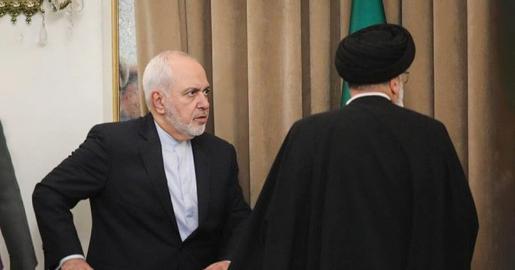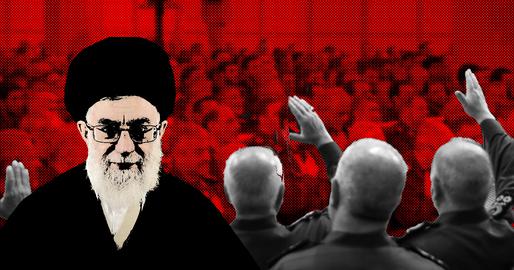
Politicians operate within a circle, a support group that performs various functions from managing day-to-day affairs, offering counsel and extending influence, making secretive contacts the politician does not wish to publicize, and much more. The exact nature of these functions and the composition of rings within the circle depends on the character of the politician, his past (this is Iran, so we're going with he), the political culture in which he is operating, and the level of power the politician has achieved.
Studying the circles can be interesting in itself, but more importantly, it can tell us a great deal about a politician and the directions which he is likely to take.
The circle takes time to form and shrinks or expands with the politician. For example, in 2011, Hassan Rouhani, the current president of Iran, wrote a book entitled National Security and Economic System of Iran. Three others helped him write the book and all three are now members of his inner political circle: Mohammad Nahavandian, an Iranian-American economist and his chief of staff, Mohammad Bagher Nobakht, head of Management and Planning Organization, and Akbar Torkan, his chief advisor.
This is common enough in every country around the world and should not strike anybody as odd. In the Islamic Republic of Iran, however, these circles follow patterns that might not be so common or familiar, whether in case of Rouhani’s circle or for others.
Family First
Since the beginning of the Islamic Republic in 1979 that brought the clergy to power, the families of political leaders have been the key variables in the most deciding and complex political equations. The Ayatollah Ruhollah Khomeini’s youngest son, Ahmad, ran his office. The current Supreme Leader's brother, Mohammad Khamenei, was his prominent supporter in the parliament and the Leader’s son, Mojtaba, is now the center of gravity in the activities of his father’s office. Former presidents followed the same pattern, as was the case with Rafsanjani's brother and son, Khatami’s two brothers, and Ahmadinejad’s brother. In Rouhani’s office, this role is played by his brother, Hossein Fereydoon.
Over the past three decades, the circles formed by the families of Iranian leaders have resembled powerful political parties which can exert great influence on the selection of cabinet members and serve as their poles in interactions with other political forces and as arbiters of the very direction of government.
Members of the first ring in the circle have complementary and sometimes overlapping characteristics. They are members of the extended family or have worked with the No. 1 for many years, or have considerable influence on various layers of the government. Some are skillful financial operators, while others are charismatic or are powerful in the higher echelons of security or military institutions. When half a dozen or dozen people like that form a circle around No. 1, other political, executive or economic rings take shape rapidly.
The results are not always desirable or the circle may change rapidly and profoundly, like the circle around Ahmadinejad, but sometimes it enjoys a lasting position of influence, like the one around the former president Rafsanjani.
Taking the this past into account, knowing the members of Rouhani’s circle and what they stand for becomes a very important element in making sense of what may transpire down the political road.
Emerging Rings
Five months is not enough time for the formation of a powerful and influential circle, but a look at past cooperation, personal relationships, and the similarity of political views and positions we can see the emergence of two political rings in Rouhani’s circle.
The following lists could be confusing because, as yet at least, many of the figures are not known outside Iran, even to those who follow the Iranian politics rather closely. However it can still provide a general idea of what positions the members occupy. (Some figures do have online bios in English. Click on their names to find out more.)
Prominent members of the first ring include: Mohammad Nahavandian (chief of staff), Hossein Fereydoon (brother and special assistant), Mohammad Bagher Nobakht (vice-president for planning), Hessameddin Ashena (advisor) and Mohammad Reza Sadegh (advisor).
The second potential ring is made up of figures who share political views: Eshaq Jahangiri Kouhshahi (first vice-president), Majid Ansari (parliamentary vice-president), Akbar Torkan (advisor), Ali Younesi (advisor), Mohammad Ali Najafi (advisor) and Mahmood Sariolghalam (advisor).
To Rouhani’s circle we should add high-level cabinet ministers who can speed up or slow down the formation of potential circles or affect the influence and power of actual ones: Mohammad Reza Nematzadeh (minister of industry and mining), Mohammad Javad Zarif (foreign minister), Mahmoud Vaezi (communications minister), and Bijan Namdar Zangeneh (oil minister).
Things become more bewildering if we add the influence of powerful and potentially overlapping circles around outside figures such as former presidents Rafsanjani and Khatami, or Ali Larijani, the speaker of the parliament. The boundaries would become clearer as time goes by and as events such as the next parliamentary elections draw closer.
Ring Number One
The closest partners of Rouhani share certain elements. In main they support the free market and politically are moderates who position themselves between hardliners and reformists. They don’t have fond memories of reformists under former President Khatami and are not strongly inclined to work with them, but neither do they want to be associated with the hardliners. At the same time, they jealously protect their connections in both camps.
They have strong security credentials and have credible government records. They now control the institution of presidency, government-owned media (thanks to the green light shown by the minister of Islamic Culture and Guidance), and key economic ministries. As a result, they are also in control of bridges to the private sector. Since the Abdolreza Rahmani Fazli, the Interior Minister, is a known conservative, they have enough maneuvering room to influence the selection process of provincial governors. The close connections between Nahavandian, chief of staff, and Nobakht, vice-president for planning, with the speaker of the parliament (in which hardiners are dominant) will permit them to exert some influence on the legislative body, even though the parliamentary vice-president, Majid Ansari, is known as a reformist.
The other area in which they have to compete for influence is the economy. Elections for the board of the Iranian Chamber of Commerce resulted in victory for the candidates close to Rouhani’s chief of staff. The media portrayed it as a victory for the allies of Jahangiri, the first vice-president, but Nahavandian’s friends were very comfortable claiming credit to advertise his influence.
This was not an isolated incident. The resignation of the commerce vice-president from the ministry of industries, himself a reformist, showed that differences of opinion about economic policies are widespread in the lower echelons of the circle. The important point about this circle is that they know they have a weak political backing. The only political party supporting them is the Moderation and Development Party, founded by Rouhani in 2002. It has little social support, political presence or organization. As such they must rely on expanding the circle to expand their power and influence.
Those Problematic Reformists
Another factor is the problems created by the presence of reformists in Rouhani’s circle. For obvious reasons, including the sensitivities of the Supreme Leader and the pressure of the conservative parliament, the president is not willing to give reformists too much space in which to maneuver. Showcasing them helps Rouhani maintain his social credibility and hopes for a recovery; but if they gain power, their presence in the lower echelons will spread and this is not something that the governing system welcomes.
For the moment, then, the balance of power favors the first ring. They have important supporters such as former presidents Rafsanjani and Khatami. Despite limitations in controlling key government-owned media, they have more maneuverability because the reformist media support them.
The more independent figures in this group give them a chance to deal with events such as the upcoming parliamentary elections with more clarity and, perhaps, to enter into clear-cut political coalitions. But before making any serious attempts at entering the parliamentary elections, they are thinking more about their continued existence, strengthening their position and gaining the confidence of the leadership.
One important difference between the second ring and the first ring is that members of the second ring have more partisan tendencies and are inclined to present their political identities within known political frameworks, not by identifying with a circle. This approach, of course, is not necessarily a good thing. It can result in fragmentation and falling behind in political competition—something those with decent medium-term memory can recall.
Channeling Wagner
Telling the future of Rouhani’s circle is not an easy task. In previous administrations of the Islamic Republic, the more homogenous composition of the government helped analysts to provide more plausible sketches of the government's trajectory. In the political circle around Rouhani, we have both Mostafa Pourmohammadi, the minister of justice who has been accused of mass killings, and Masoumeh Ebtekar, vice-president and head of the environmental protection agency, who also served under the reformist president Khatami. The figures that we mentioned have serious differences in economic and cultural views.
With parliamentary elections approaching and major macroeconomic decisions looming, internal competition within the circle is likely to intensify. Under Khatami the cabinet was politically more homogenous but differences over macroeconomic policies gave rise to some of the more intra-cabinet serious clashes.
The rumors about the resignation of Eshaq Jahangiri from the first vice-presidency show that the first ring wants to extend its power. If it can capture the position of the first vice-president, it would have the maximum space to maneuver.
This ring is likely to become more powerful if it can improve the cooperation between the government and the parliament and if the hardliners win the parliamentary elections.
The absence of political tensions among the members of this ring, their proximity to the center of power and their repeated affirmations of devotion to the Supreme Leader gives their circle a better chance to endure. They don’t feel that they owe much to those who voted for Rouhani, and as a result aren't especially preoccupied by Rouhani's image and public sentiment.
The distance between this ring and politics makes it possible for them to better harness economic, political and security resources.
Playing it Both Sides
The main ring around Rouhani is not troubled with the pursuit of democracy. Its priority is development and its motto is “Develop Iran”. What is more believable, however, is that it wants to develop and expand its own reach—something like the difference between “privatization” and “personalization”!
But not all hardliners would welcome the expansion of power by this ring, especially not the fundamentalists, but for the moment it is keeping the reformists in check. As such, it plays the role of a trump card for use when needed. The Supreme Leader has shown that he prefers a balance of power among various political factions and Rouhani shows the same attitude. The first ring in the president’s circle knows this and has mastered its strateggy: play both sides of the field, but favor one side more.
A strong hand for this ring would not only satisfy the higher-ups but would also reinforce the position of influential figures such as Ali Larijani, the speaker of the parliament. This kind of peripheral support can reduce meddling and give the ring a chance to expand.
From this vantage point one can predict that they would follow the model of Ahmadinejad’s administration: suffer to be a “public corporation” in the first term but move towards a “private partnership” in the second.
visit the accountability section
In this section of Iran Wire, you can contact the officials and launch your campaign for various problems
























comments